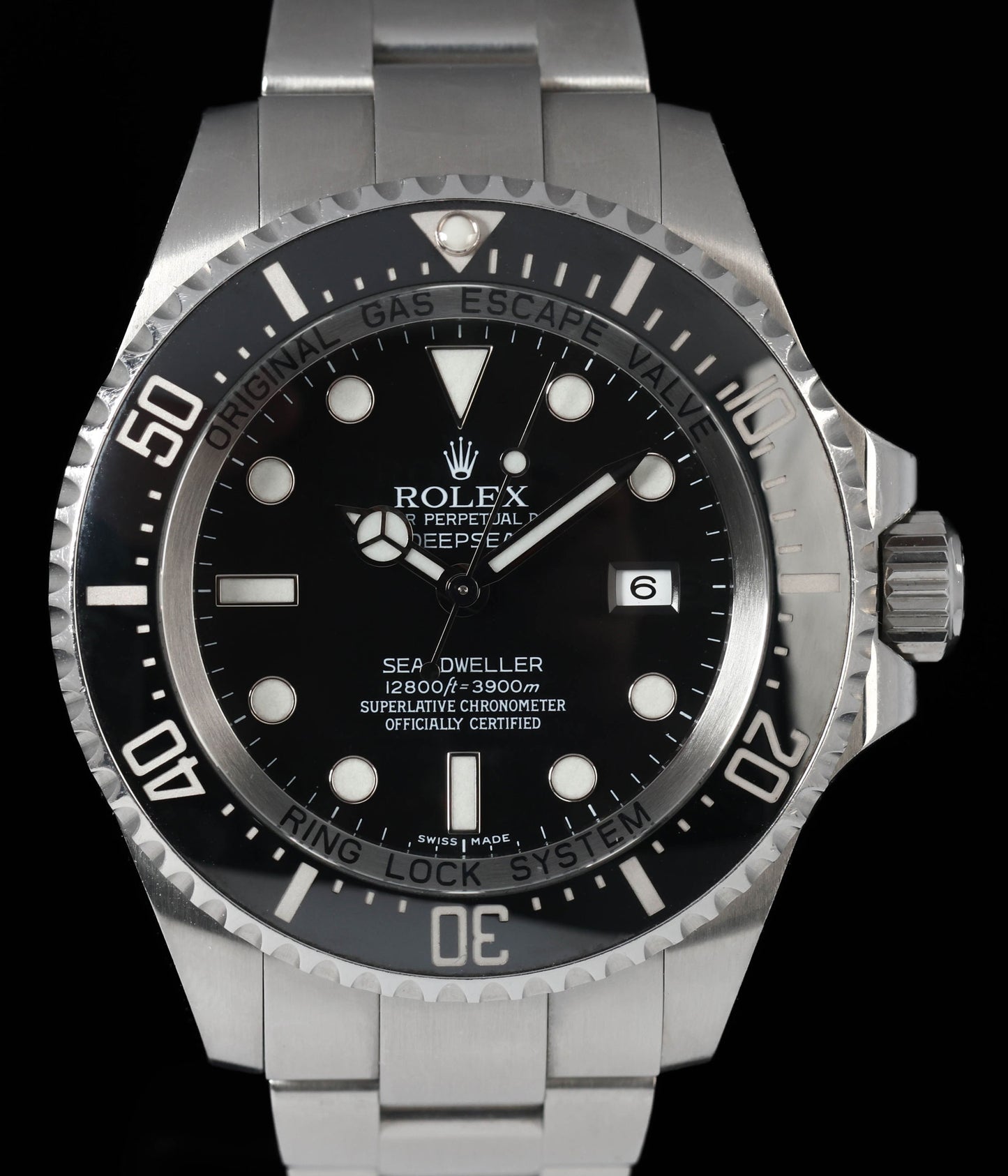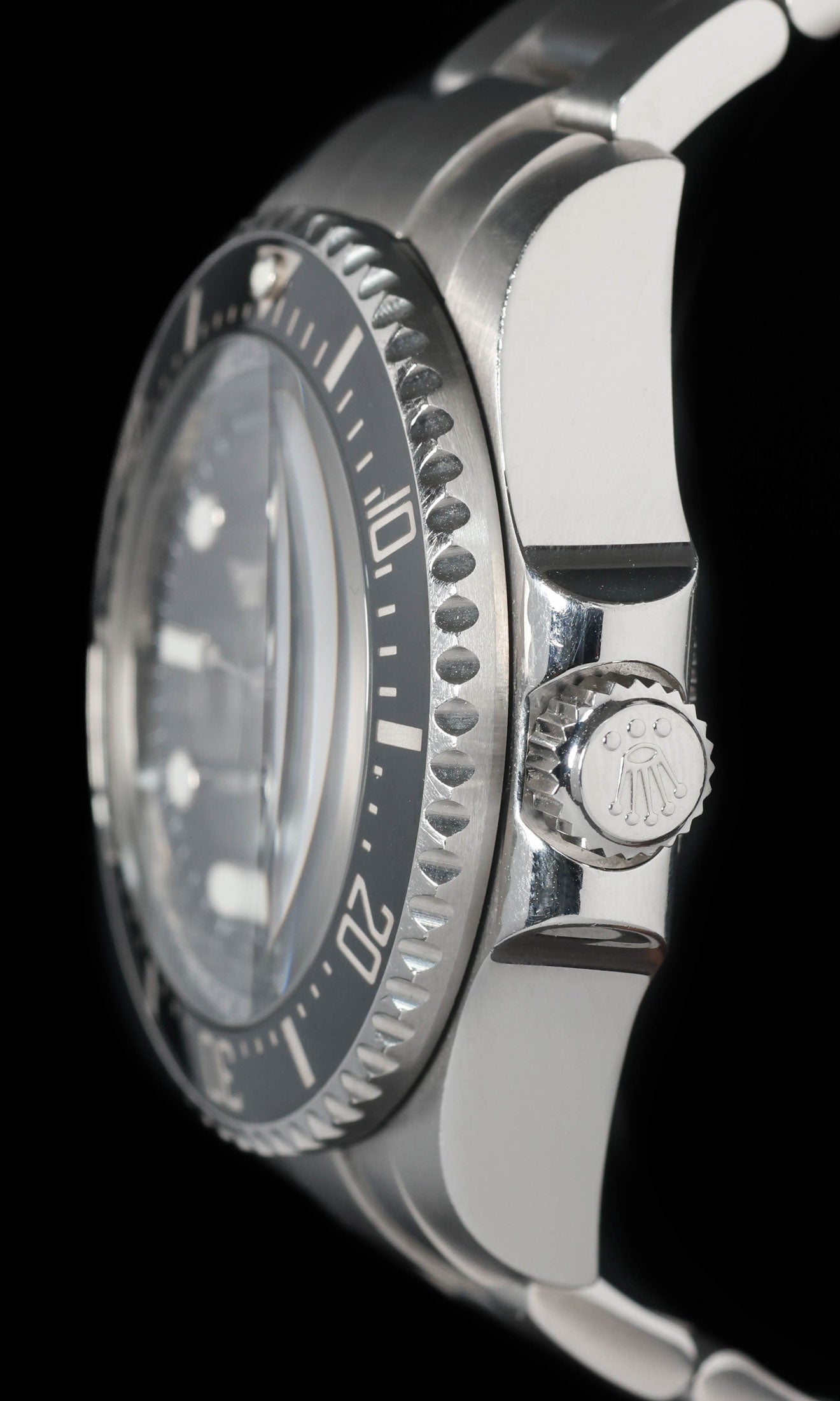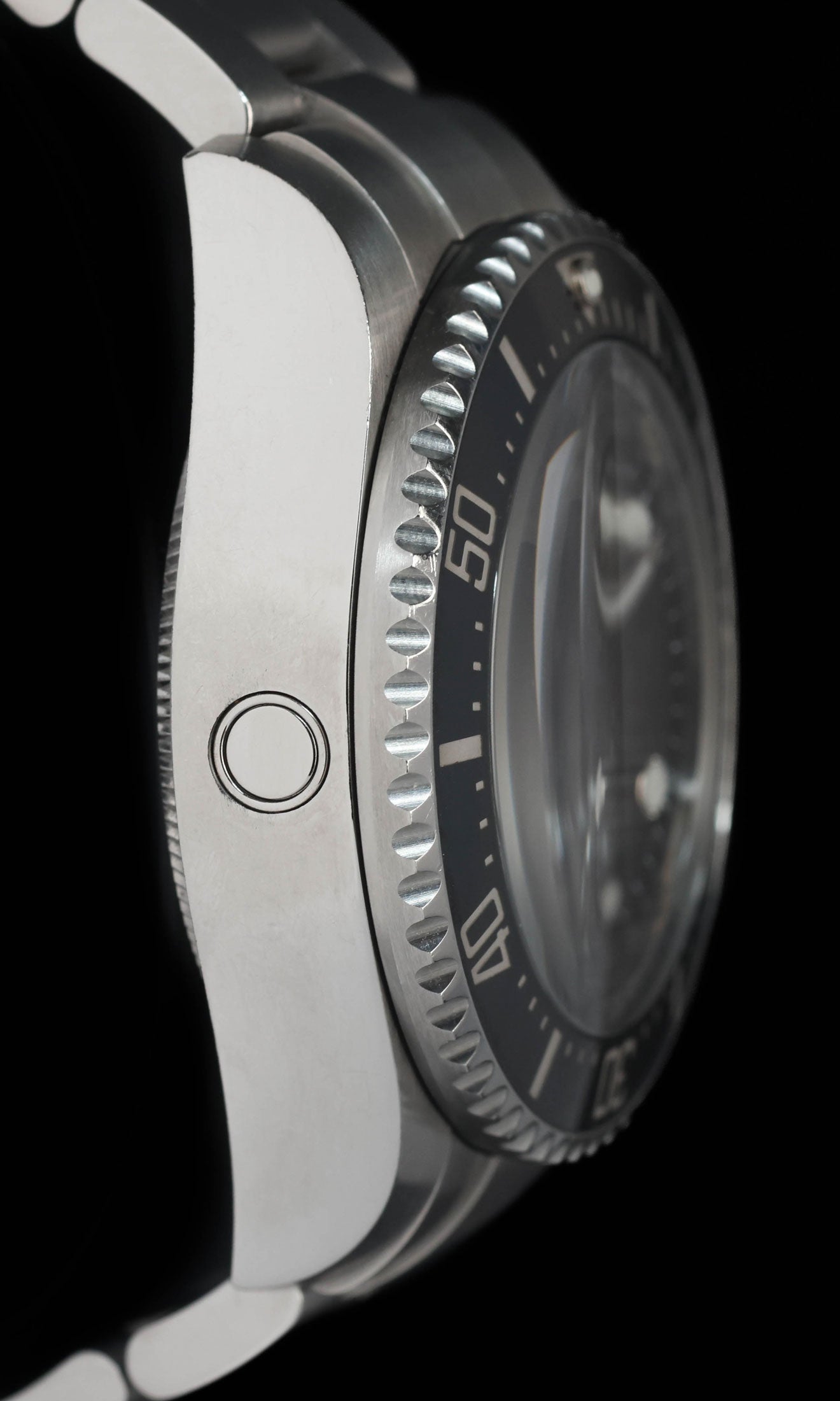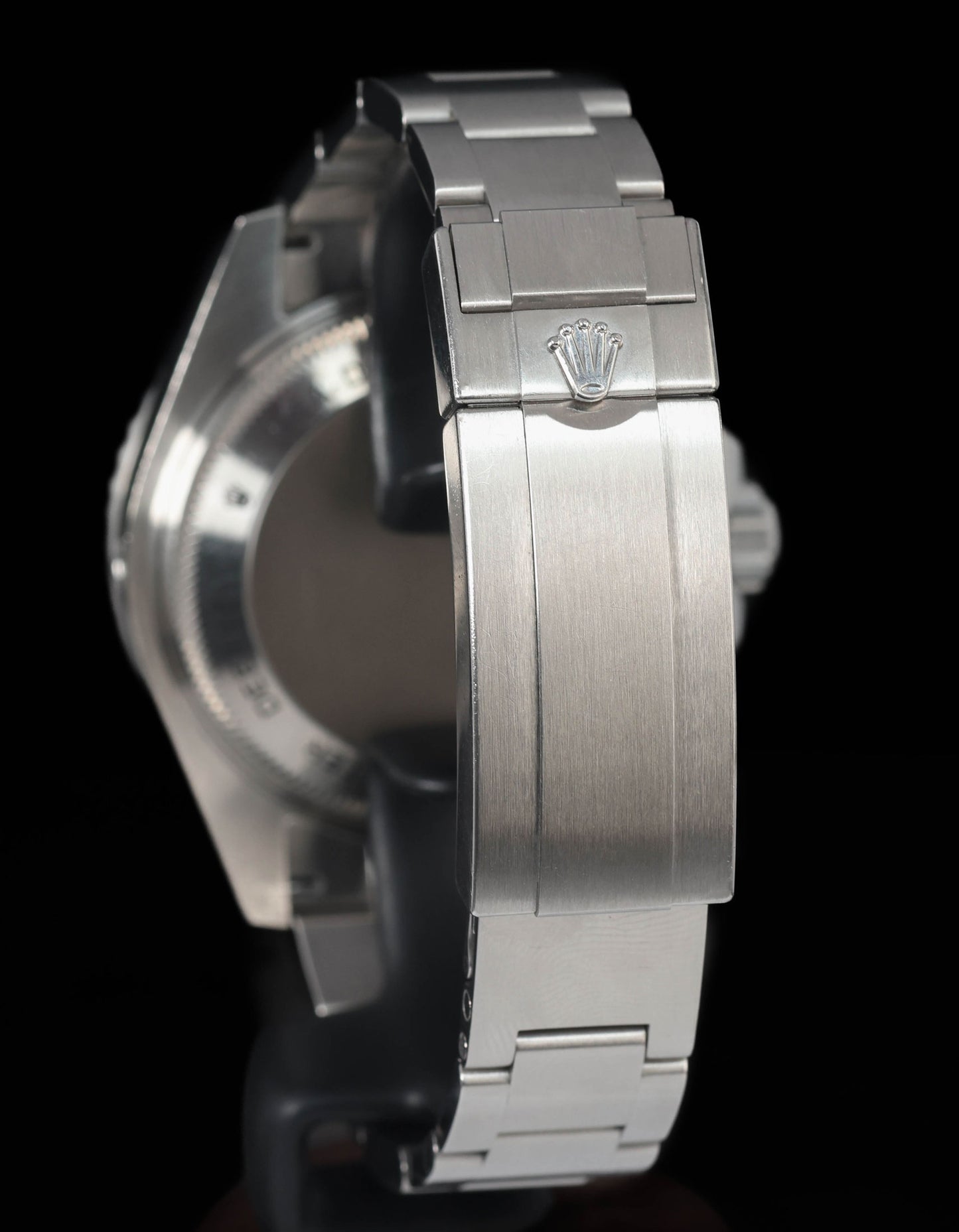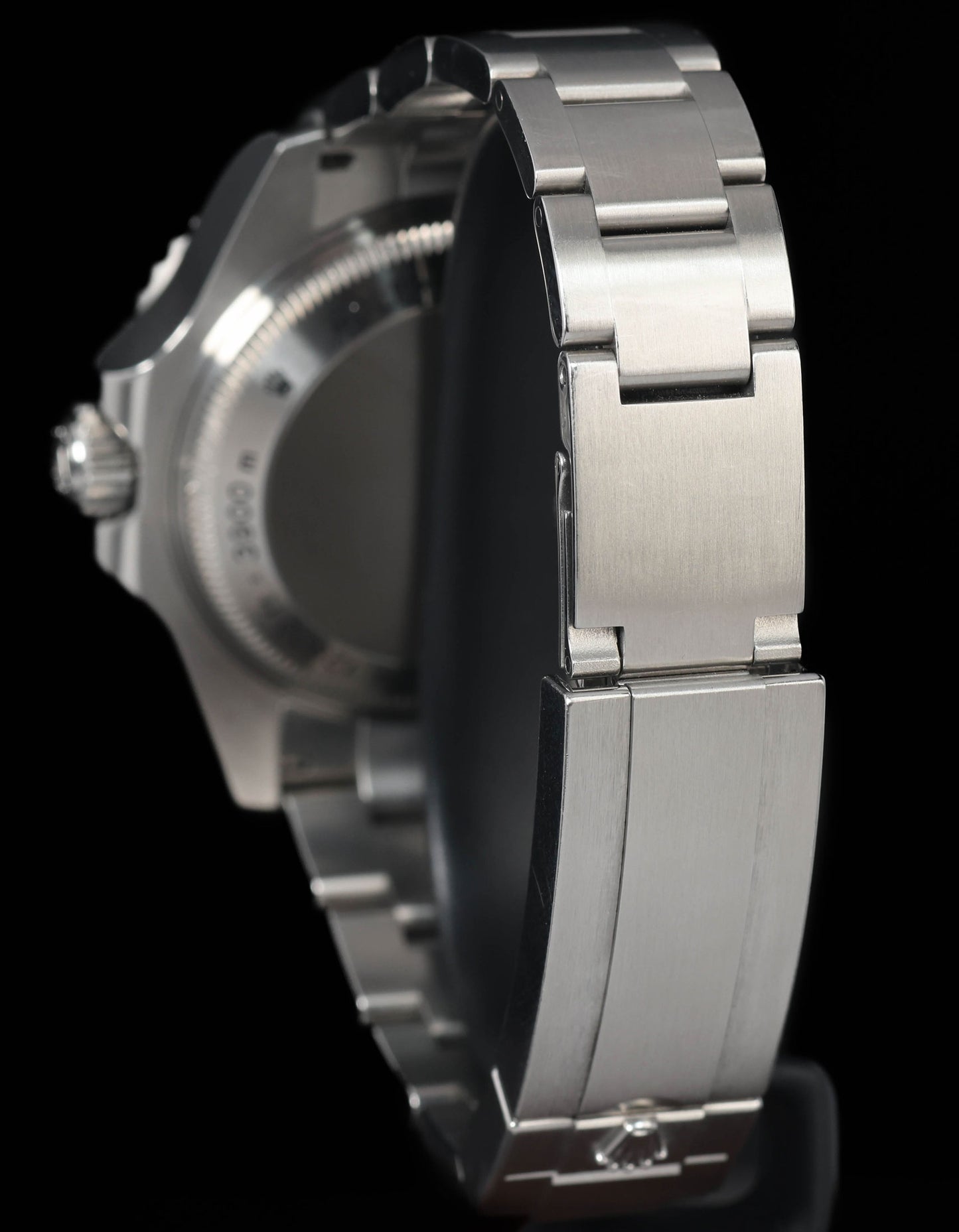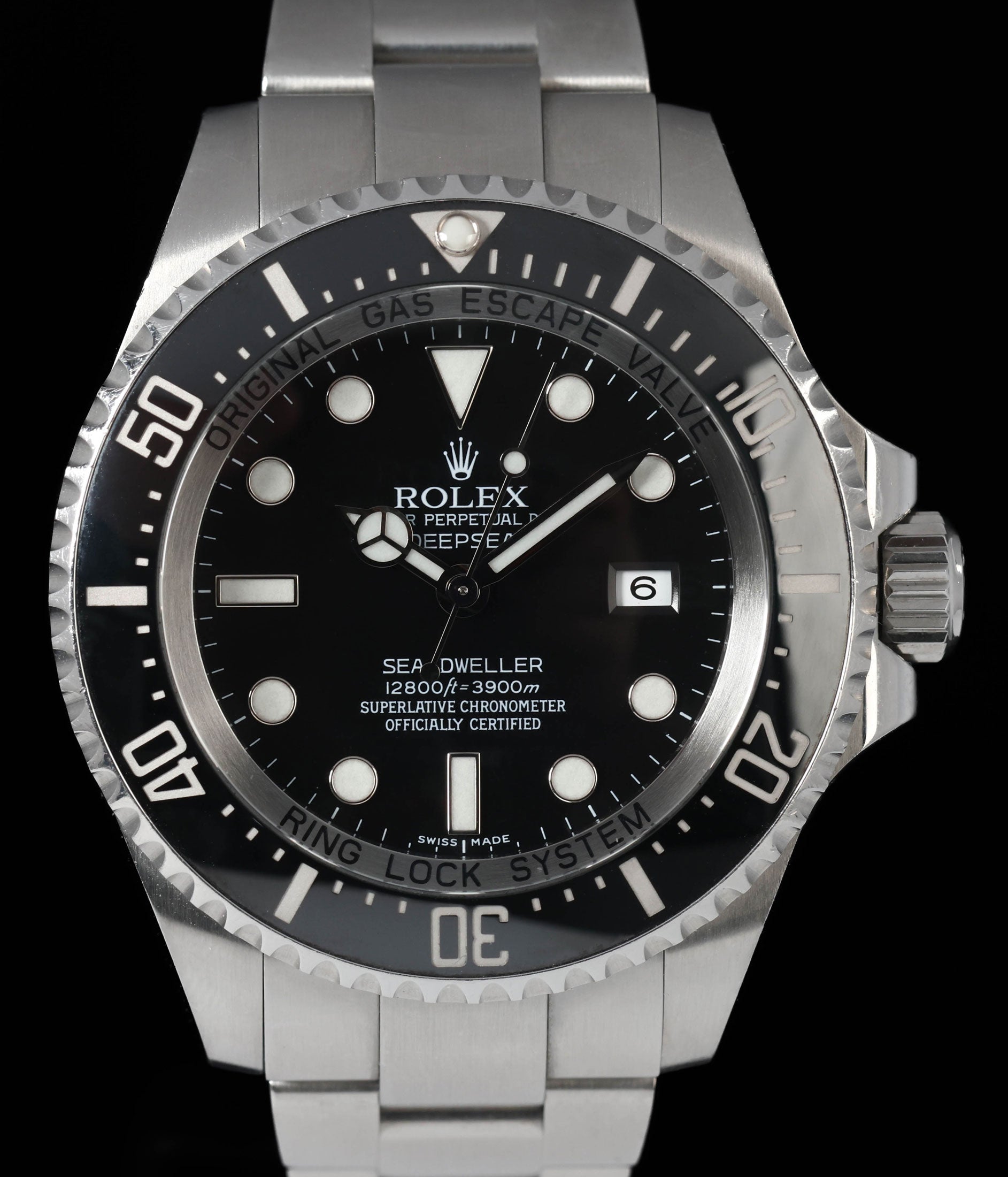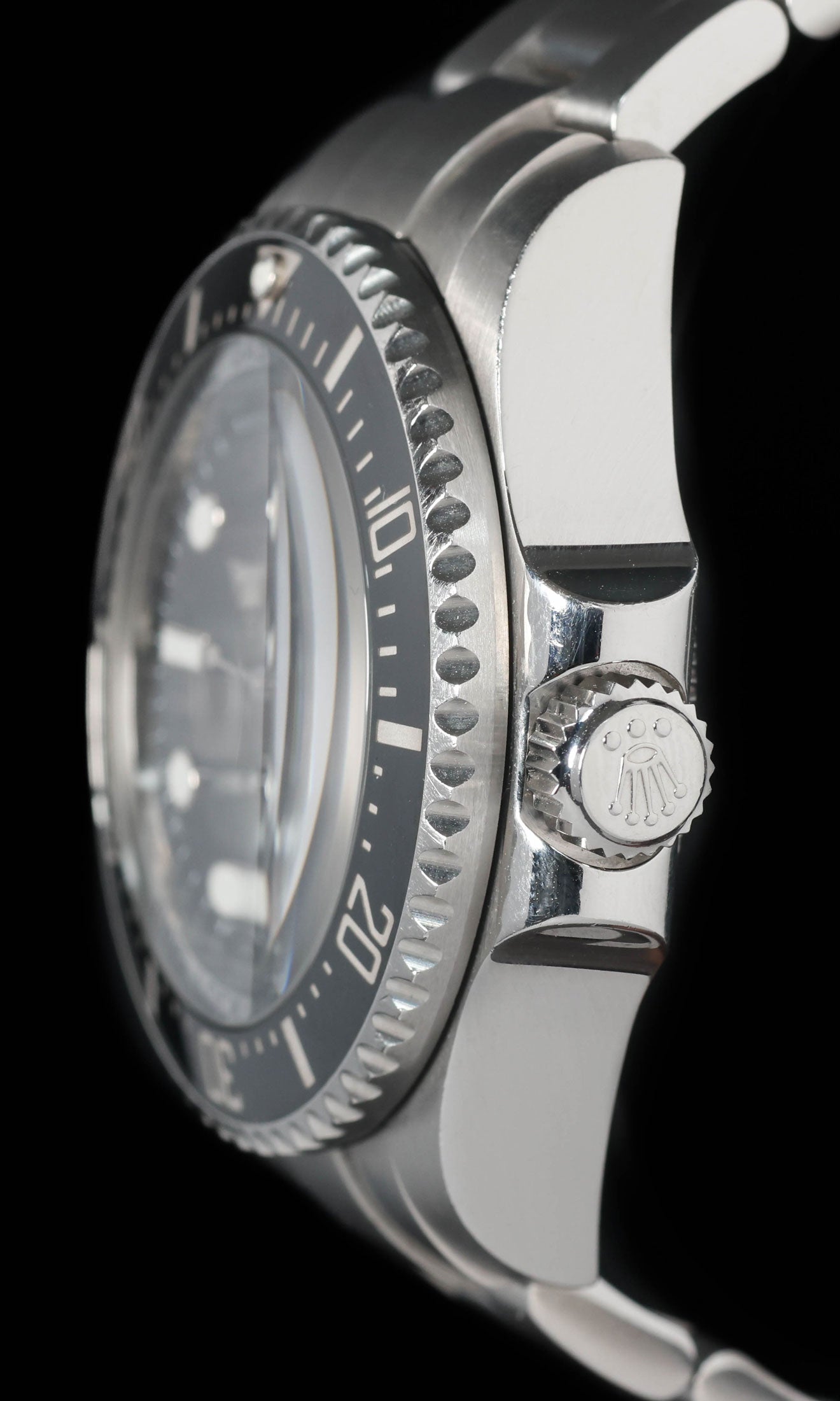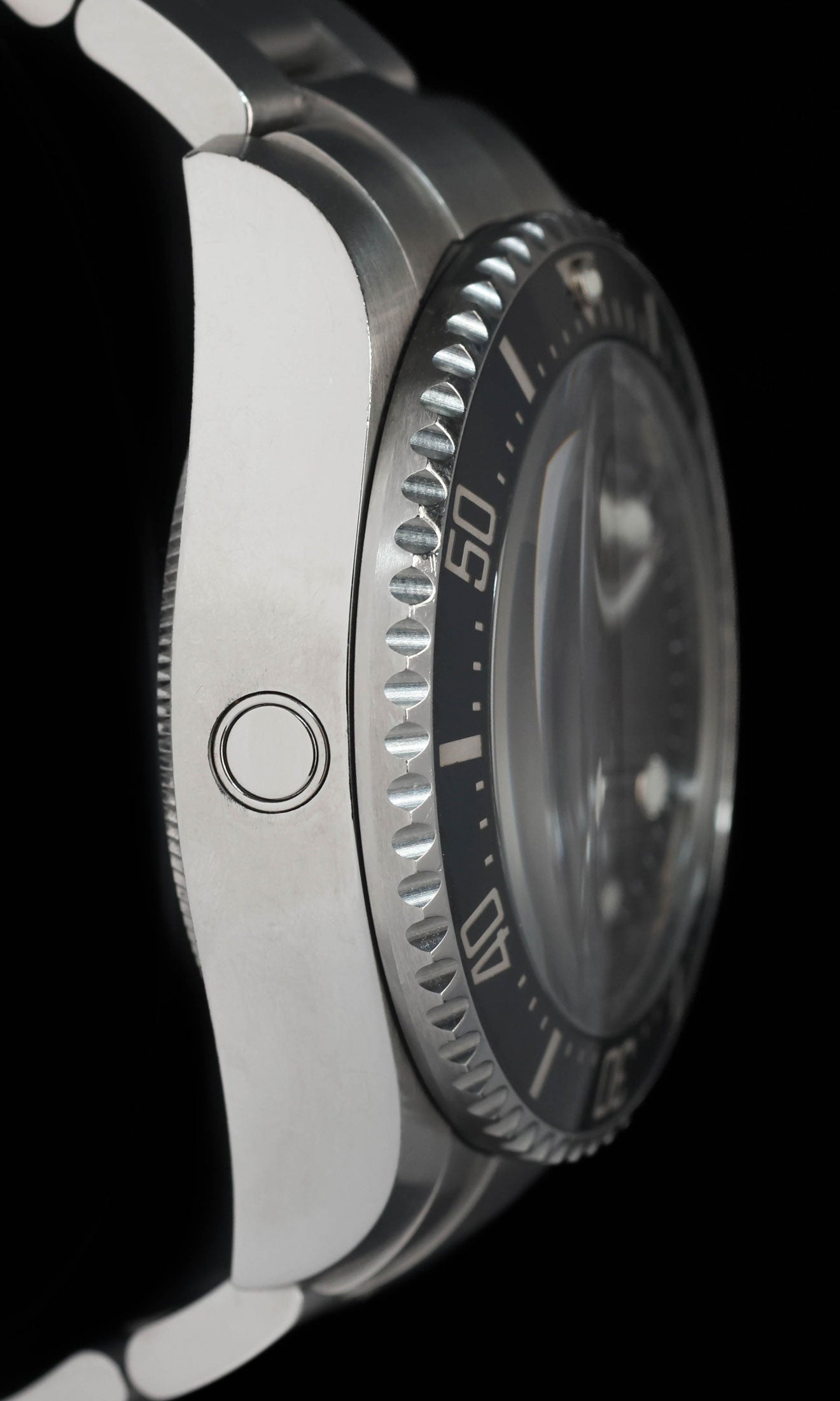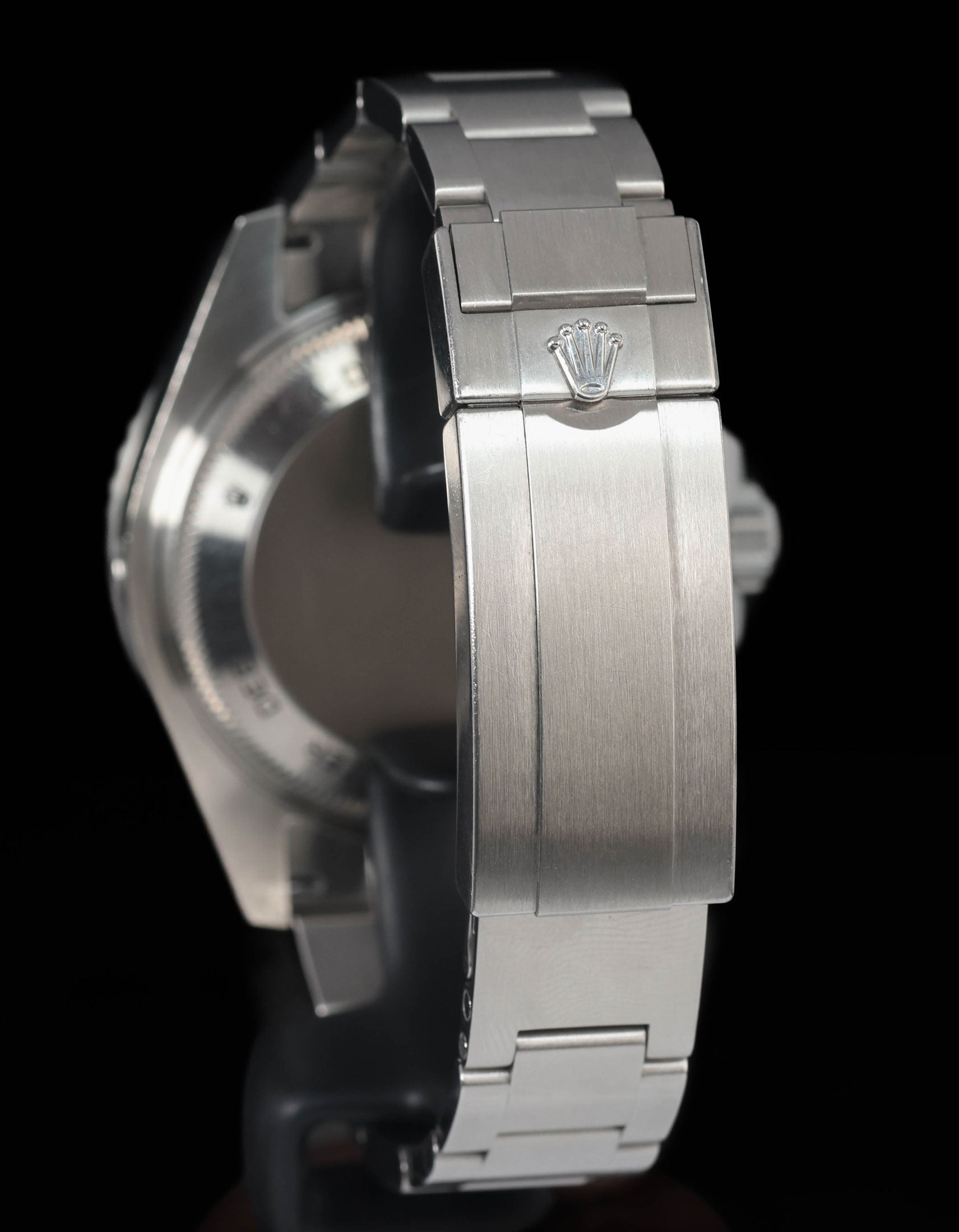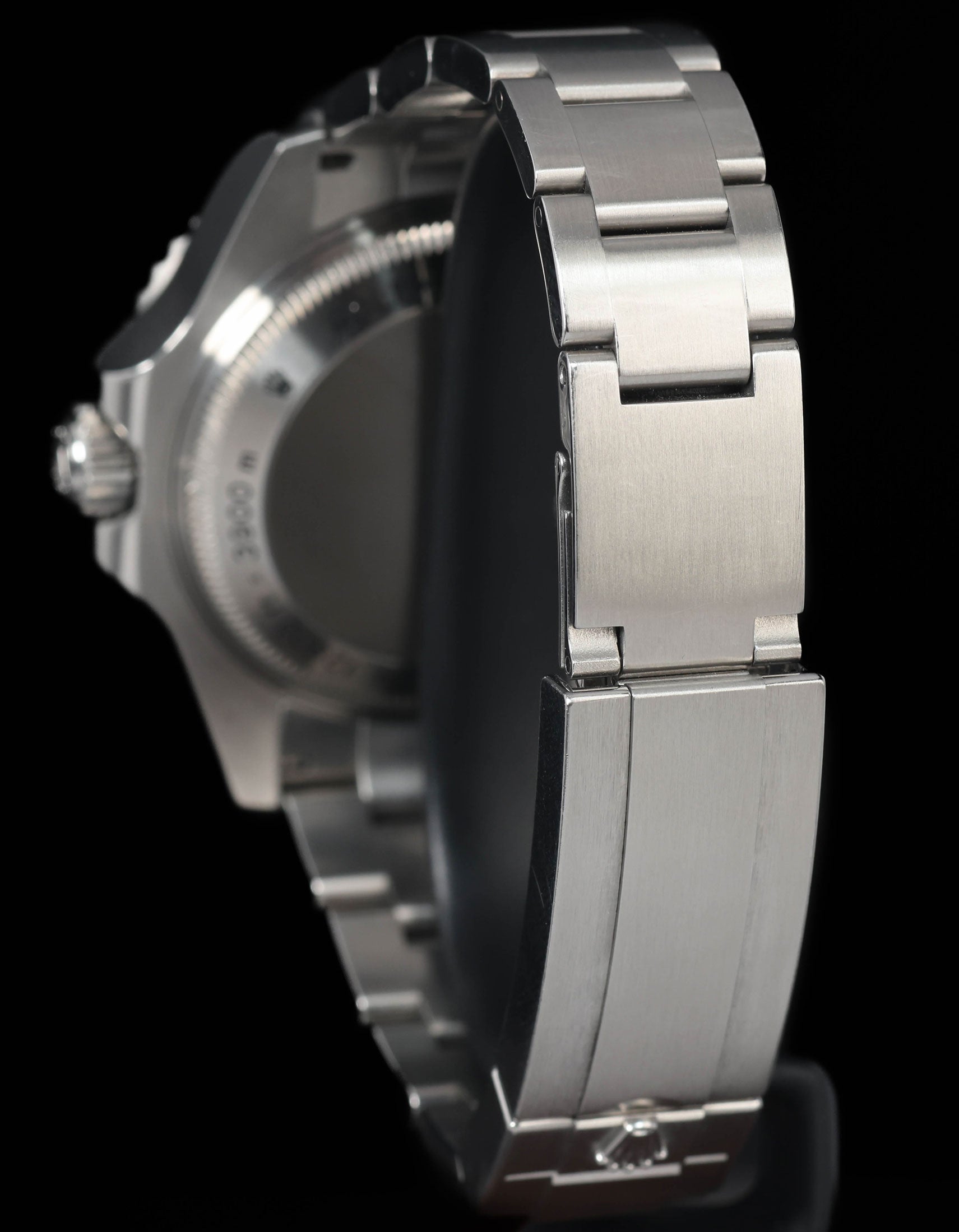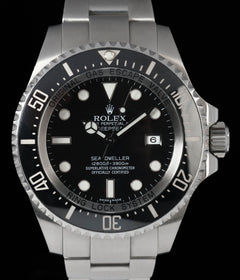Crown Vintage
Rolex Deep Sea Dweller 44MM 116660 | 2009
Rolex Deep Sea Dweller 44MM 116660 | 2009
Couldn't load pickup availability
Very good overall condition. The 44 mm Ringlock case shows only light surface swirls and retains its original brushing and sharp factory edges; no evidence of polishing. Ceramic bezel is clean and free of chips, with crisp numerals and fully intact Chromalight pearl. Sapphire crystal remains clear and unmarked. Dial and hands are excellent—flawless gloss, perfect Chromalight fill, and no lume loss or discolouration. Crown and helium-escape valve thread smoothly and seal properly. Calibre 3135 winds, sets and runs within expected tolerances. Oyster bracelet displays minimal stretch; clasp blades snap shut securely and Glidelock mechanism operates as intended. Overall, a well-preserved Deepsea that has seen careful wear only.
Share
Why we love this watch
Why we love this watch
Rolex Deepsea 116660: the 44 mm professional diver that redefined saturation-grade engineering
Introduction
When the Rolex Deepsea reference 116660 arrived in 2008 it signalled a decisive technical leap for the Geneva brand’s dive catalogue. Designed to survive 3 900 metres below the surface—around twelve times deeper than a conventional recreational limit—the watch introduced a new Ringlock architecture, an oversized 44 mm case and innovations in crystal design, case-back metallurgy and bracelet adjustability. Although its proportions and thickness (17.7 mm) proved polarising on land, the 116660 established a modern benchmark for commercially available mechanical dive watches and underscored Rolex’s long-standing relationship with deep-ocean exploration.
Historical backdrop
Rolex had pursued ultra-depth experimentation since the 1953 Bathyscaphe Trieste programme, when a prototype Oyster accompanied Jacques Piccard and Don Walsh to 10 916 metres in the Mariana Trench. The commercial Sea-Dweller followed in 1967, offering a helium escape valve and a 610 m rating for North Sea saturation divers. By the early 2000s offshore drilling rigs and scientific submersibles were working significantly deeper, and rival brands were publishing four-figure depth ratings. Rather than tweak the Sea-Dweller’s mid-case yet again, Rolex engineers embarked on a blank-sheet design under project code “Deepsea” that could comfortably exceed the 3 000 m threshold targeted by saturation contractors such as COMEX.
Engineering the Ringlock system
Key to the 116660’s pressure survival is a three-part load-bearing assembly dubbed Ringlock. At its heart sits an internal nitrogen-alloyed stainless-steel compression ring shaped like a broad washer; during immersion the massive forces acting on the 5.5 mm sapphire crystal and the grade-5 titanium case-back are channelled into this annulus rather than the softer 904L outer shell. Calculations showed that the ring, rated to 13 tonnes, absorbs up to 90 per cent of the crystal’s deflection load, allowing Rolex to keep the watch wearable without resorting to an impractically thick monocoque.
The case-back itself illustrates Rolex’s willingness to break material conventions. Earlier Sea-Dwellers had closed with standard steel; the Deepsea instead uses a slightly domed titanium alloy held in place by a 904L locking ring. Titanium’s elasticity allows it to flex microscopically under pressure, maintaining the hermetic seal without risk of permanent deformation. In static tests performed at COMEX’s hyperbaric facility in Marseille each finished watch endured 125 per cent of its rated depth, equivalent to 4 875 metres, for more than an hour.
Case dimensions and sealing strategy
A larger shell was unavoidable. The external diameter grew to 44 mm, the lug-to-lug span to 51 mm and the crown guards became broader to protect the oversized Triplock crown. Rolex kept the traditional Oyster screw-down architecture but redesigned the crown tube to accommodate a thicker internal gasket stack. The helium escape valve remains at the nine-o’clock flank, now machined from a single steel billet and fitted with a conical spring calibrated to open automatically at around 3.0 bar differential pressure. During six-day saturation runs this prevents the crystal from popping as the habitat is depressurised.
The bezel follows Submariner conventions—a unidirectional 120-click ring with a ceramic Cerachrom insert—but its assembly had to withstand greater torsional stress in cold water. Rolex solved this by housing the ratchet in a nitrogen-treated stainless-steel bezel ring and installing a thicker bi-directional snap spring to handle accidental knocks when gloved. The raised “pearl” at 60 minutes holds a platinum-filled Chromalight capsule that glows blue for up to eight hours.
Dial variants and legibility
For the launch year Rolex delivered a gloss-black dial with printed white markers framed by white-gold surrounds. Each applied marker and the “Mercedes” handset received Chromalight luminous paint, chosen for its longer afterglow compared with the earlier green Super-Luminova. Minute hash marks extend fully around the rehaut to allow accurate decompression timing. Enthusiasts quickly noted the introduction of an engraved “ROLEX ROLEX ROLEX” chapter ring and a discreet “Swiss Made” flanked by twin coronets at six o’clock.
In 2014 the brand added the D-Blue variant to mark James Cameron’s 2012 solo descent to the Challenger Deep. Its gradient dial transitions from midnight blue at 12 o’clock to pitch black near six, mirroring the fading light experienced during a submersible dive. The word “DEEPSEA” appears in vivid green, mimicking Cameron’s Deepsea Challenger submersible, while other text remains white. Although mechanically identical, the D-Blue became an independent SKU and generated significant wait-list demand until the reference was retired in 2018.
Bracelet and clasp innovation
Given the case mass—well over 200 g on the steel bracelet—Rolex reinforced the Oyster link architecture. Centre links are solid and slightly thicker than those on a Submariner Date, and the end-links nestle tightly against the curved lugs to eliminate lateral play. Two complementary adjustment mechanisms help the watch accommodate a wetsuit without tools.
First, the Fliplock extension folds out of the clasp, adding 26 mm in one motion. Second, the Glidelock rack inside the clasp allows incremental 2 mm steps up to an additional 20 mm. Together they cover everything from a 3 mm neoprene sleeve to a bulky 7 mm drysuit cuff. The clasp body itself is milled from a single steel piece, and its double-locking blades bear chamfered shoulders to avoid snagging diver gloves.
Movement: calibre 3135
Throughout its decade-long production the 116660 ran on Rolex’s calibre 3135. Launched in 1988, the movement had proved its reliability in millions of Submariners and Datejusts before being pressed into Ringlock duty. Featuring a full balance bridge, a free-sprung Microstella balance wheel with a blue Parachrom hairspring and a large single-piece rotor, the 3135 provides a conservative 48-hour power reserve at 28 800 vph. Rolex rated the Deepsea to the then-standard COSC tolerance of −4/+6 seconds per day, but factory regulation often reduced actual deviation to within ±2 seconds.
While the newer Sea-Dweller 126600 moved to calibre 3235 with a 70-hour reserve, many owners appreciate the 3135’s long servicing track record and abundant parts availability. Its date mechanism remains quick-set, an essential convenience for a watch likely worn only intermittently given its bulk.
Wrist presence and daily practicality
On paper the Deepsea seems unwieldy. In practice its curved lugs, balanced clasp weight and modest 44 mm span give it better stability than many ultra-large divers. The sapphire’s pronounced dome and thick crystal gasket contribute much of the 17.7 mm height, though the watch still tucks under a loose cuff. Many owners run it on an aftermarket rubber strap with a titanium deployant to shave weight, reserving the steel bracelet for specific dive trips.
Visibility underwater is superb. The wide handset, tall applied markers and anti-reflective coating on the crystal’s underside minimise glare even when ambient light fades after 30 metres. Chromalight emits a clear blue hue that does not overwhelm night-adapted vision yet remains legible at the recommended 25 cm checking distance during dark evacuations.
Exploration pedigree and the D-Blue dial
James Cameron’s Deepsea Challenge documentary, released in 2014, chronicled his record-setting plunge to 10 908 metres with an experimental Rolex strapped to the submersible’s manipulator arm. Although the prototype measured 51.4 mm by 28.5 mm, its architecture directly evolved from the 116660 Ringlock formula. Rolex capitalised on the media coverage by offering the gradient D-Blue dial to the public later that year, reinforcing the marketing narrative linking commercial ownership to extreme-depth triumphs.
While some purists prefer the pared-back black dial, the D-Blue’s colour shift has become a symbolic shorthand for the modern Deepsea line, much as the red line on a 1665 Sea-Dweller evokes early COMEX associations. It remains the only stainless-steel Rolex production model to employ a graduated dial finish, making it a distinctive visual departure within the professional range.
Collectability and ownership considerations
Although the watch sat in catalogue production for a full decade, annual volumes were modest compared with Submariner Date runs, owing to higher manufacturing complexity and narrower consumer appeal. Early specimens with the “Mark I” dial—distinguished by slightly more generous spacing in the word “DEEPSEA”—have attracted scholarly attention, as have pieces retaining their soft plastic bezel-guard and full 2008-dated warranty set.
The D-Blue, produced from 2014 to 2018, has historically carried a secondary-market premium over the black dial, not because of functional differences but for its direct thematic link to the Challenger expedition and its shorter time in production. Nonetheless, both variants share identical engineering and should be evaluated on overall originality: unpolished cases show a subtle vertical grain across the case sides, and chamfers on the lugs remain thin from the factory. Over-zealous refinishing erases these clues and can reduce collector interest.
Rolex Deepsea in the context of professional references
Within the wider Rolex dive hierarchy the 116660 occupies a unique niche. It sits above the 40 mm Submariner and the 43 mm Sea-Dweller 126600 in depth rating, mass and case thickness, yet it remains the only model to employ the Ringlock platform. When the Sea-Dweller grew to 43 mm in 2017 many expected Rolex to retire the Deepsea, but the company’s decision to update it instead with broader bracelet lugs and improved clasp proportions in the 126660 successor affirmed its continued relevance.
Real-world saturation divers seldom require a 3 900 m rating—commercial bell runs rarely exceed 500 m—but the redundant safety margin delivers marketing gravitas and peace of mind. It also extends Rolex’s tradition of producing purpose-built tools that exceed present-day professional standards, much as the GMT-Master’s 24-hour hand once outstripped airline cockpit requirements.
Final thoughts
The Rolex Deepsea 116660 is more than a larger Sea-Dweller; it is a platform conceived around a pressure-bearing ring, titanium elasticity and a crystal thickness bordering on the improbable for a wrist-worn instrument. Its introduction ushered in new clasp ergonomics and re-established Rolex’s primacy in the escalating depth-rating race of the early twenty-first century. For many enthusiasts the model represents the last of the five-digit-style professional watches before the shift to calibre 3235 and broader lugs. Whether chosen for actual helium-saturated operations or as a symbol of technical accomplishment, the 116660 remains a significant chapter in Rolex’s engineering narrative, embodying the brand’s relentless pursuit of functional excess in the service of underwater reliability.
Case & Bracelet
Case & Bracelet
Case and bracelet is in good condition with hairline scratches on case. Bracelet is in great condition with very light hairline scratches.
Dial & Hands
Dial & Hands
Dial and hands are flawless.
Warranty & Condition
Warranty & Condition
Crown Vintage Watches provides a minimum 3-month mechanical warranty on pre-owned watches, from the date of purchase.
The warranty covers mechanical defects only.
The warranty does not cover damages such as scratches, finish, crystals, glass, straps (leather, fabric or rubber damage due to wear and tear), damage resulting from wear under conditions exceeding the watch manufacturer’s water resistance limitations, and damage due to physical and or accidental abuse.
Please note, water resistance is neither tested nor guaranteed.
Shipping and insurance costs for warranty returns to us must be covered by the customer. Returns must be shipped via traceable courier. Return shipment must be pre-paid and fully insured. Collect shipping will be refused. In case of loss or damages, the customer is liable.
Our Pledge
At Crown Vintage Watches, we stand by the authenticity of every product we sell. For added peace of mind, customers are welcome to have items independently authenticated at their own expense.
Condition
Due to the nature of vintage timepieces, all watches are sold as is. We will accurately describe the current condition and working order of all watches we sell to the best of our ability.
Shipping & Refund
Shipping & Refund
